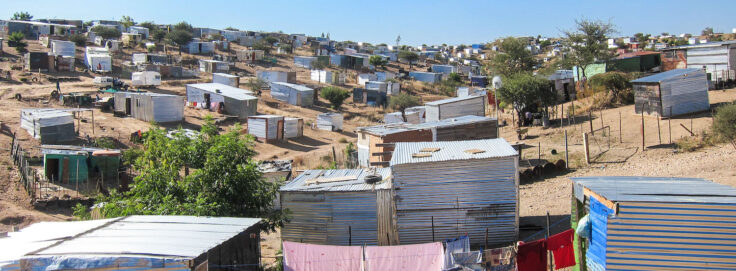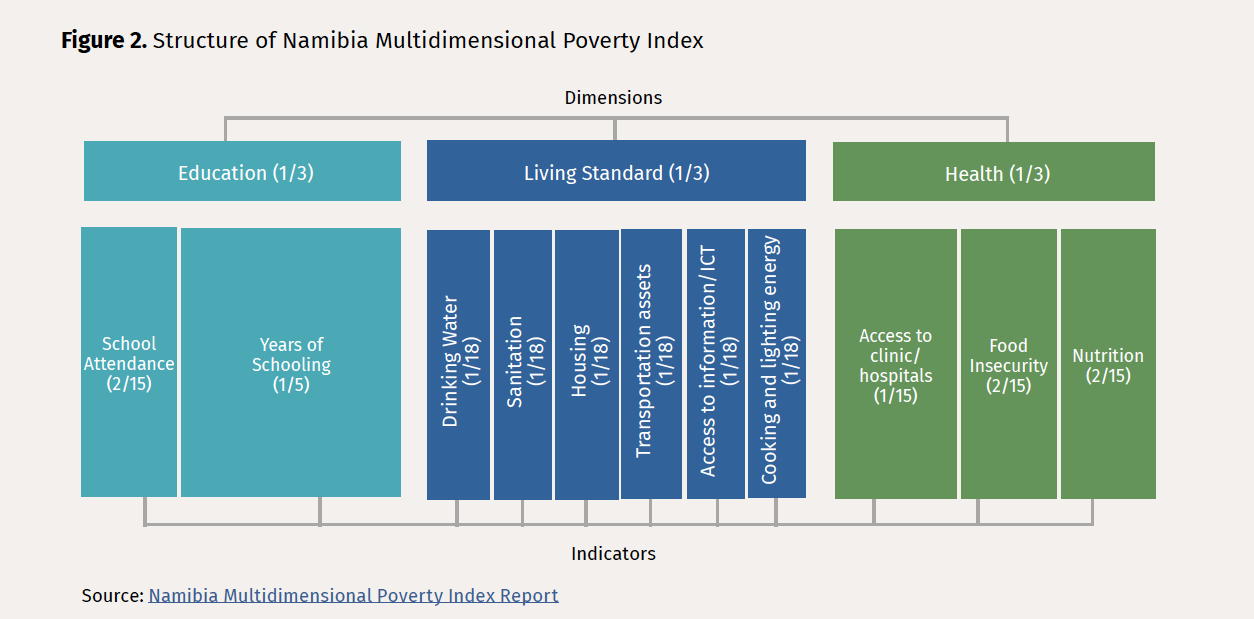
Search
Supporting the budgetary process with a national MPI: An interview with Fransina Amutenya from Namibia

Namibia launched its first national MPI in June 2021following extensive consultations with stakeholders across government, NGOs and academia. In this interview, Fransina Amutenya discusses the construction and implementation of Namibia’s national MPI with Kelly-Ann Fonderson. Fransina Amutenya is a Senior Statistician at the Namibia Statistics Agency (NSA). Her work specialises in poverty, welfare and gender statistics.
The process of creating the Namibian MPI included extensive consultations with government and academia. How did the Namibia Statistics Agency (NSA) approach this and what would you recommend to other government officials beginning this stage in other countries?
The structure of Namibia’s MPI (NAMPI) is a result of a series of discussions led by the NSA, the National Planning Commission (NPC), the United Nations Children’s Fund (UNICEF) – Namibia, the United Nations Development Programme (UNDP)– Namibia, and the United Nations Population Fund (UNFPA) – Namibia.
The design and computation of the national MPI has included consultations and discussions with the national steering committee, which was comprised of various offices, ministries and agencies (Ministry of Finance; Ministry of Education, Arts and Culture; Ministry of Agriculture, Water and Land Reform; Ministry of Urban and Rural Development; Namibia University of Science and Technology; University of Namibia; Institute for Public Policy Research; National Planning Commission; Ministry of Gender Equality, Poverty Eradication and Social Welfare; and Ministry of Health and Social Services) to ensure that the MPI is tailored to the local context using Namibian-specific indicators to provide a comprehensive understanding of country-level multidimensional poverty.
 The steering committee met whenever necessary, but not less than twice a month. These consultations were necessary for stakeholders to understand their respective roles in revising the measure and make sure the proposed indicators were collected in the next data source.
The steering committee met whenever necessary, but not less than twice a month. These consultations were necessary for stakeholders to understand their respective roles in revising the measure and make sure the proposed indicators were collected in the next data source.
The NSA, as the lead institution in the development of the NAMPI, is responsible for updating the estimations whenever new data becomes available, i.e., every five years. Governments planning to adopt the MPI in their respective countries should ensure they have key stakeholders in the established study steering team based on the chosen dimensions and indicators.
In addition, where possible, they should include the technical staff from relevant institutions during the capacity-building trainings. For Namibia, this was offered with support from OPHI virtually over a span of one month. This was necessary for building capacity across Nambia’s National Statistical System (NSS) for understanding the methodology in-depth, as the NSS were later consulted in the process for their inputs into the dimensions, indicators, and cutoffs.
How were the dimensions, indicators, and weights of Namibia’s MPI chosen?
Several factors guided the creation of Namibia’s MPI. Mainly, the selection of dimensions, indicators, and cutoffs was determined through a consultative process of the steering committee, drawing on expertise from many different sectors and reflecting National Development Plans (NDPs) and priorities.
Other factors that were considered included the availability of data from the selected data source, as well as an examination of the global MPI and its dimensions and indicators.
The global MPI consists of three dimensions: ‘Living standards’, ‘Health’ and ‘Education’, measured across ten indicators. While Namibia’s MPI retains these three dimensions, the indicators have been adjusted to better reflect the specific context and priorities of the country.
How has Namibia’s MPI supported the implementation of Namibia’s National Development Plans (NDP)?
While the NSA’s core mandate is to produce official statistics in the country, the government of Namibia, specifically the National Planning Commission (NPC) is the custodian of the formulation and implementation of National Development Plans (NDP).
The NDP5, or the fifth National Development Plan for Namibia, which started in April 2017, completed its term in March 2022. Although the first MPI for Namibia was only published in 2021, the results are being used by the National Planning Commission to evaluate the NDP5 and consequently provide baselines for NDP6.
Furthermore, the national MPI supports the budgetary process of the Ministry of Finance in the allocation of resources to the three sectors namely education, urban and rural development, and health.
The MPI is included in the budgeting equation by the affected sectors at the national level and not necessarily the MPI poor individuals.
The NSA is planning regional disseminations in September 2022 from which a session on how the Regional Councils can use the MPI in its budgeting process will also be presented.
Child poverty was an important focus in the 2021 Namibia Multidimensional Poverty Index Report. How has the national MPI been used to help alleviate child poverty in Namibia?
Since the publishing of the national MPI in June 2021, two policy advocacy engagements have taken place between the NSA and UNICEF-Namibia focusing specifically on the Namibian children.
Regional infographics have also been developed and scheduled for dissemination in the 14 administrative regions of the country by the NSA and UNICEF-Namibia in 2022.
This article was published in Dimensions 14


















